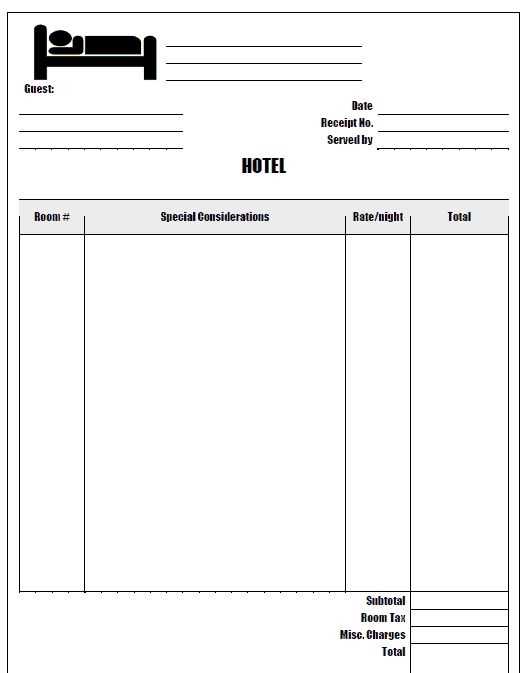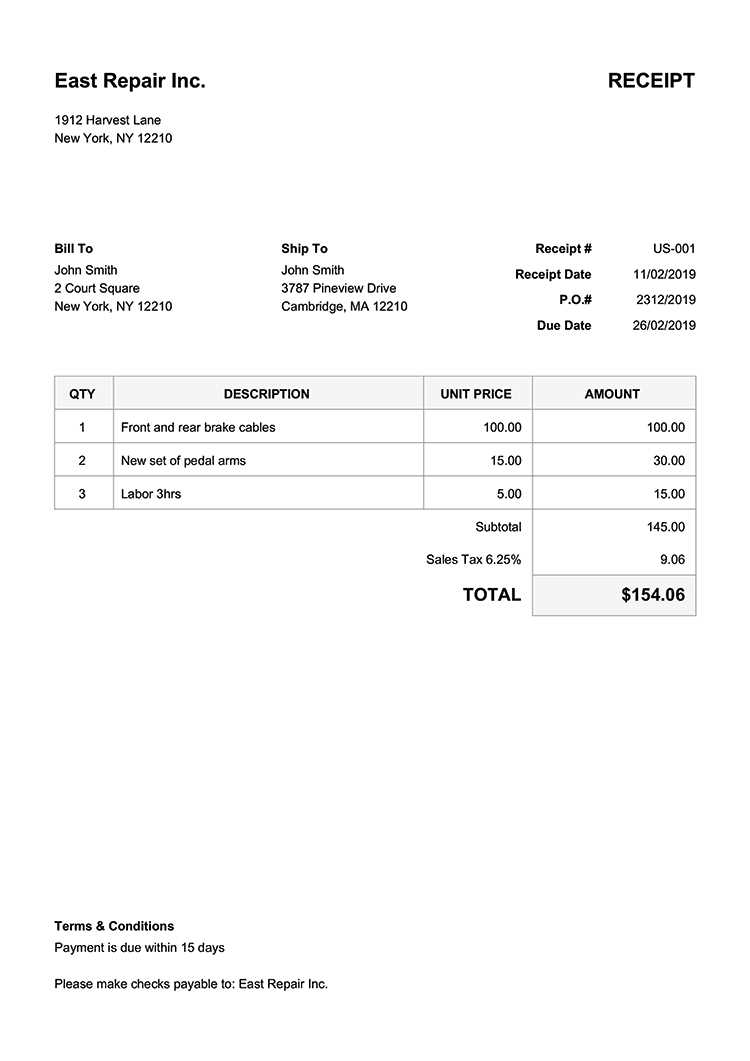
Use a simple and clear accommodation receipt template to provide your guests with all necessary details regarding their stay. Include the guest’s name, check-in and check-out dates, accommodation type, and total amount paid. This keeps everything transparent and organized, ensuring that both parties have accurate records.
For clarity, break down the charges, such as room rate, additional fees, taxes, and any discounts. This gives the guest a detailed overview of the payment and minimizes confusion. Don’t forget to add your contact information and a unique receipt number for future reference.
Consider adding a section for the payment method used, whether it’s cash, card, or another method. This helps verify the transaction details and makes the receipt complete. A clean, structured template will make it easy for your guests to review their stay details and for you to keep accurate records.
Accommodation Receipt Template Guide
Designing a clear and professional accommodation receipt is key to ensuring both the provider and guest have all necessary information on hand. A well-structured template makes the process easier and more transparent for everyone involved.
The basic elements of an accommodation receipt include the following:
| Element | Description |
|---|---|
| Guest Name | The full name of the guest staying at the property. |
| Accommodation Details | The name of the property, address, and room details (e.g., room number or type). |
| Check-In and Check-Out Dates | The dates when the guest checked in and out of the accommodation. |
| Total Amount Paid | The total amount paid for the stay, including any taxes or service charges. |
| Payment Method | The method used for payment, such as credit card, cash, or bank transfer. |
| Receipt Number | A unique number for reference and tracking purposes. |
| Host Contact Information | The contact details of the accommodation provider in case of follow-up. |
Ensure each element is clear and easy to read. Avoid overcrowding the document with unnecessary details that may confuse the guest. Including a table format is a good choice for organizing the data in a user-friendly way.
Keep the receipt format simple, leaving room for personalization when needed. This can include adding a custom logo or a special note to thank the guest for their stay.
Creating a Simple Accommodation Receipt Format

Begin by listing the accommodation provider’s name, address, and contact information at the top of the receipt. This makes it easy for guests to verify the details of their stay. Include the accommodation type (hotel, apartment, etc.) and the date of stay for clear reference.
Guest and Stay Details
Next, include the guest’s full name, check-in date, and check-out date. Specify the room or unit number and any additional services provided, such as meals or parking. Include the rate per night or unit and a breakdown of any extra charges, such as taxes or service fees.
Total Payment
Clearly state the total amount paid, including any prepayments or deposits, with the balance due (if applicable). If the payment was made through a specific method, such as credit card or bank transfer, mention this as well.
Finish by providing a space for the accommodation provider’s signature or a stamp as confirmation of payment. This serves as proof of transaction for both parties.
Key Elements to Include in a Receipt
To ensure clarity and accuracy, your receipt should include the following key details:
- Receipt Title: Clearly label it as a receipt at the top for easy identification.
- Seller’s Information: Include the seller’s business name, address, phone number, and email address.
- Buyer’s Information: If relevant, list the buyer’s name and contact information.
- Date of Transaction: Specify the date the transaction occurred to avoid confusion.
- Itemized List: Break down the products or services purchased, including quantity, description, and price.
- Total Amount: Clearly state the total cost, including any applicable taxes or discounts.
- Payment Method: Indicate whether the payment was made by cash, card, or another method.
Additional Details to Consider
- Transaction Reference Number: A unique number for easy tracking of the transaction.
- Return Policy Information: Include any relevant terms about returns or exchanges, if applicable.
How to Customize the Template for Different Purposes
Adjust the accommodation receipt template by focusing on key sections: header, details, and footer. For business purposes, include company branding, such as logos and contact information, at the top. For personal use, you can simplify these elements, removing unnecessary details. Ensure the guest’s name, dates of stay, and amount paid are clearly listed for transparency.
If the receipt is used for tax purposes, add fields like tax rates and any applicable fees. You may also need to include invoice numbers or reference codes. When preparing a receipt for a promotional offer, add sections for discounts or special rates, making it clear how much was saved.
For different currencies, adjust the template by changing currency symbols or adding exchange rates. Tailor the design based on where the receipt will be presented, ensuring it matches local formatting standards, such as date and number styles.
Lastly, test the layout across different devices or platforms to ensure it remains readable and professional-looking. This helps maintain consistency no matter the medium.
Legal Requirements for Accommodation Receipts
Accommodation receipts must include specific details to comply with legal regulations in various regions. These elements ensure both the guest and the accommodation provider meet legal standards for tax and documentation purposes.
- Provider Information: The name, address, and contact details of the accommodation provider should be clearly stated.
- Guest Details: The full name of the guest or customer must appear on the receipt.
- Accommodation Dates: The check-in and check-out dates are necessary for clarity and verification.
- Itemized Charges: All charges, including room rate, taxes, and any additional services or fees, should be broken down.
- Receipt Date: The date the receipt is issued must be clearly shown to confirm the transaction’s validity.
- Tax Information: The receipt should indicate applicable taxes or VAT rates, which can vary depending on the location.
In certain jurisdictions, receipts may also need to include a unique invoice or reference number for tracking purposes. Always verify with local regulations to ensure compliance.
Best Practices for Providing and Storing Receipts
Always ensure receipts are clear and contain all necessary details, such as the date, amount, and description of the services or goods purchased. This helps prevent confusion for both the provider and the recipient. When providing a physical receipt, use high-quality paper and legible fonts to avoid fading or difficulty in reading over time.
Store digital receipts in organized folders with easily identifiable file names. Consider using cloud storage solutions for secure backup, ensuring the files are easily accessible when needed. It is also wise to categorize receipts by type of purchase or project, which simplifies future retrieval and auditing processes.
For physical receipts, consider scanning them and storing them digitally. This reduces the risk of loss due to physical damage, such as fading, water damage, or fire. Ensure that scanned copies are clear and legible before storing them for future reference.
For added security, limit access to stored receipts. Only authorized personnel should have access to these records, whether physical or digital. Implement clear access protocols to prevent unauthorized viewing or tampering.
How to Generate Receipts Automatically Using Software
To generate receipts automatically, choose software that integrates seamlessly with your existing billing or payment systems. Popular tools like QuickBooks, FreshBooks, and Xero allow users to set up templates with customizable fields such as client details, payment amounts, and transaction dates. This eliminates the need for manual data entry and speeds up the invoicing process.
Select the Right Software

Select software based on the volume of transactions and features needed. Small businesses can opt for basic programs, while larger operations might require more robust tools that support multiple currencies, tax calculations, and automatic syncing with accounting systems.
Automate the Process
Set up automatic triggers within the software to generate receipts after a transaction is processed. This ensures that receipts are sent instantly via email or stored digitally, reducing human error and improving customer satisfaction. Customization options within these tools allow for branding, such as adding logos and business details to the receipt template.


